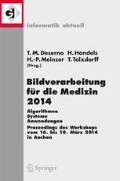Abstract
Fundus video cameras enable the acquisition of image sequences to analyze fast temporal changes on the human retina in a non-invasive manner. In this work, we propose a tracking-by-detection scheme for the optic disk to capture the human eye motion on-line during examination. Our approach exploits the elliptical shape of the optic disk. Therefore, we employ the fast radial symmetry transform for an efficient estimation of the disk center point in successive frames. Large eye movements due to saccades, motion of the head or blinking are detected automatically by a correlation analysis to guide the tracking procedure. In our experiments on real video data acquired by a low-cost video camera, the proposed method yields a hit rate of 98% with a normalized median accuracy of 4% of the disk diameter. The achieved frame rate of 28 frames per second enables a real-time application of our approach.
Access this chapter
Tax calculation will be finalised at checkout
Purchases are for personal use only
Preview
Unable to display preview. Download preview PDF.
References
Tornow RP, Kopp O, Schultheiss B. Time course of fundus reflection changes according to the cardiac cycle. Invest Ophthalmol Vis Sci. 2003;44:Abstract 1296.
K¨ohler T, Hornegger J, Mayer M, et al. Quality-guided denoising for low-cost fundus imaging. Proc BVM. 2012; p. 292–7.
Koozekanani D, Boyer KL, Roberts C. Tracking the optic nervehead in oct video using dual eigenspaces and an adaptive vascular distribution model. IEEE Trans Med Imaging. 2003;22(12):1519–36.
Loy G, Zelinsky A. Fast radial symmetry for detecting points of interest. IEEE Trans Pattern Anal Mach Intell. 2003;25(8):959–73.
Budai A, Aichert A, Vymazal B, et al. Optic disk localization using fast radial symmetry transform. Proc CBMS. 2013; p. 59–64.
Comaniciu D, Ramesh V, Meer P. Kernel-based object tracking. IEEE Trans Pattern Anal Mach Intell. 2003;25(5):564–77.
Author information
Authors and Affiliations
Corresponding author
Editor information
Editors and Affiliations
Rights and permissions
Copyright information
© 2014 Springer-Verlag Berlin Heidelberg
About this chapter
Cite this chapter
Kürten, A., Köhler, T., Budai, A., Tornow, RP., Michelson, G., Hornegger, J. (2014). Geometry-Based Optic Disk Tracking in Retinal Fundus Videos. In: Deserno, T., Handels, H., Meinzer, HP., Tolxdorff, T. (eds) Bildverarbeitung für die Medizin 2014. Informatik aktuell. Springer, Berlin, Heidelberg. https://doi.org/10.1007/978-3-642-54111-7_26
Download citation
DOI: https://doi.org/10.1007/978-3-642-54111-7_26
Published:
Publisher Name: Springer, Berlin, Heidelberg
Print ISBN: 978-3-642-54110-0
Online ISBN: 978-3-642-54111-7
eBook Packages: Computer Science and Engineering (German Language)

